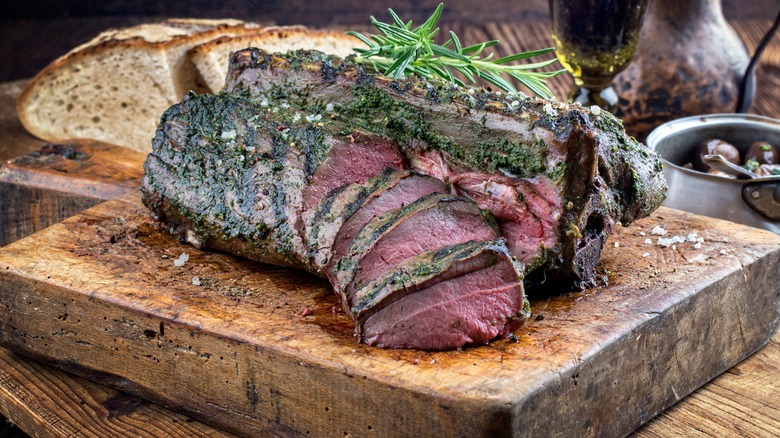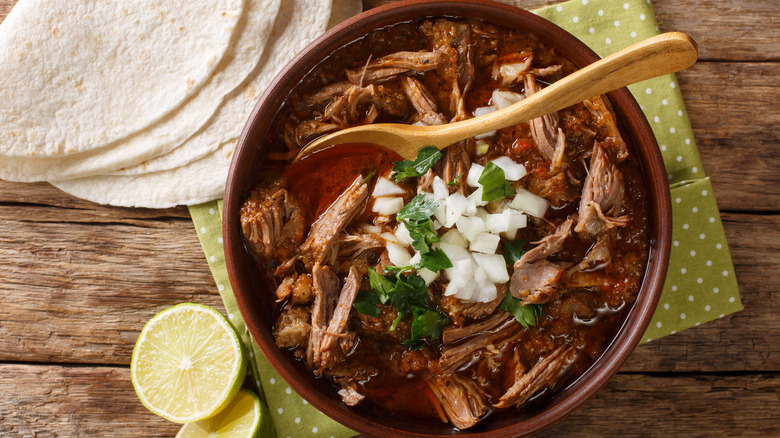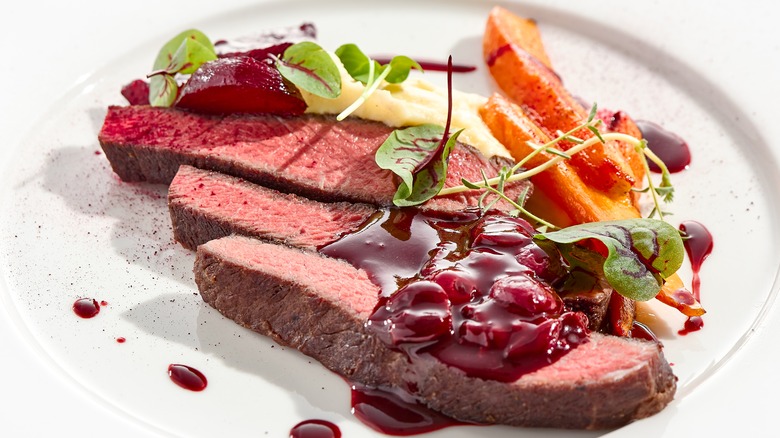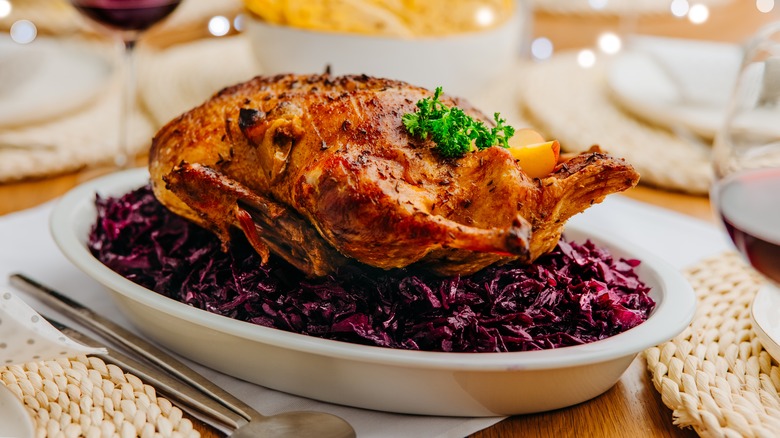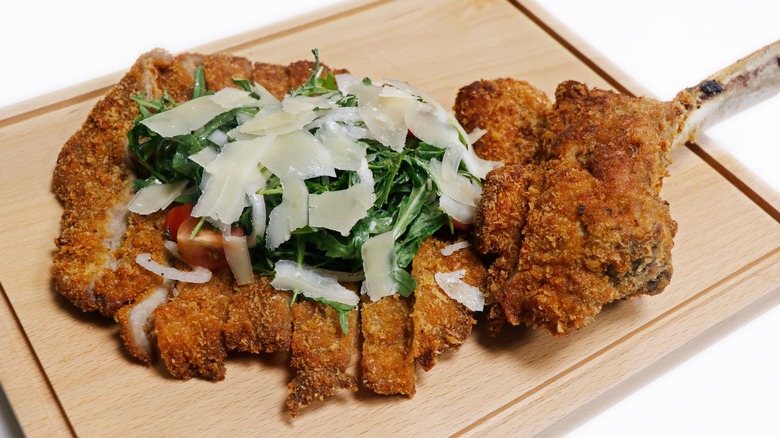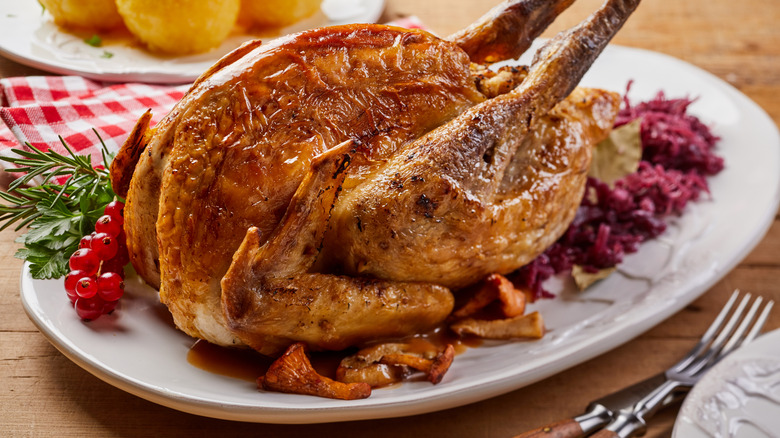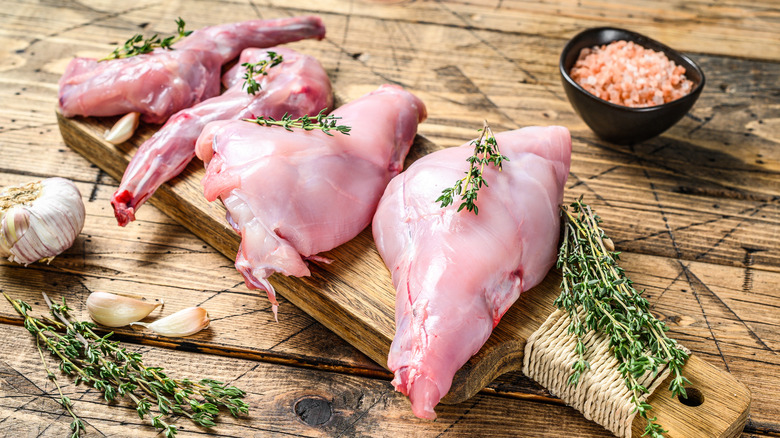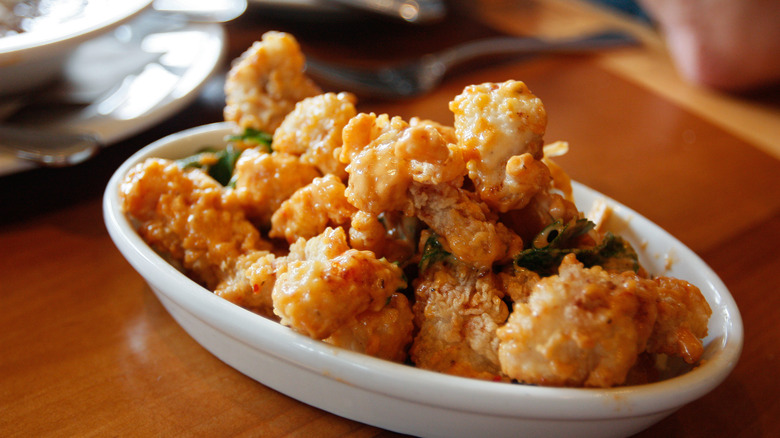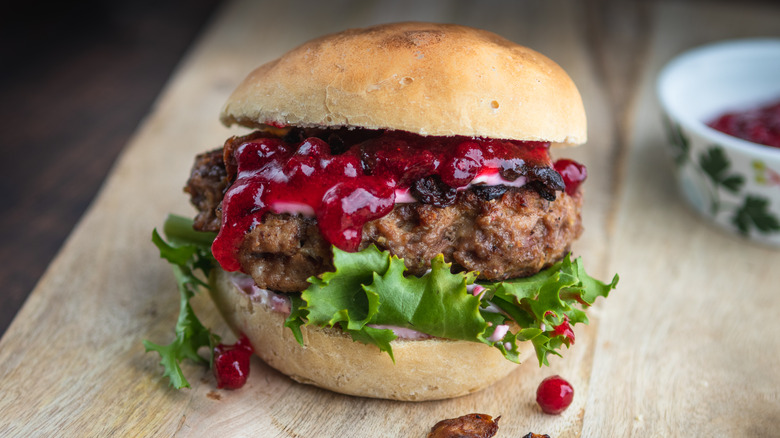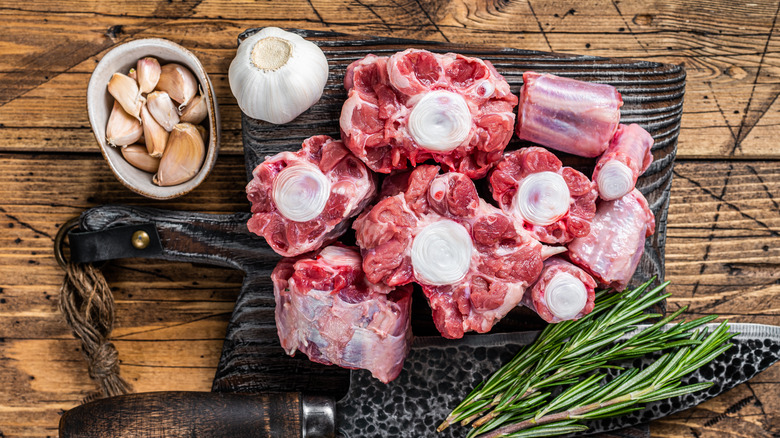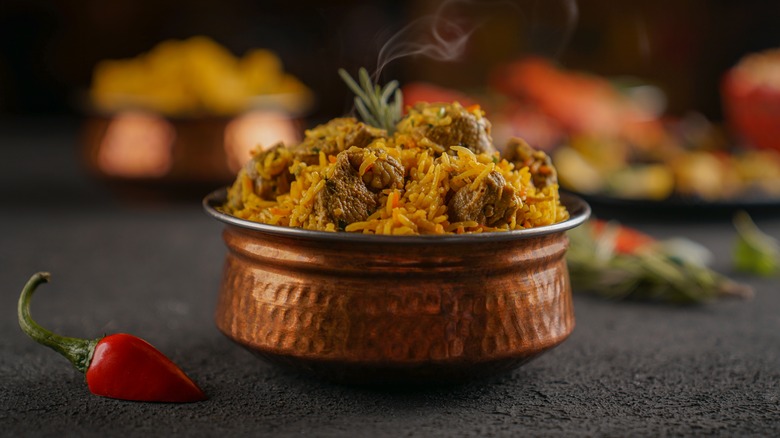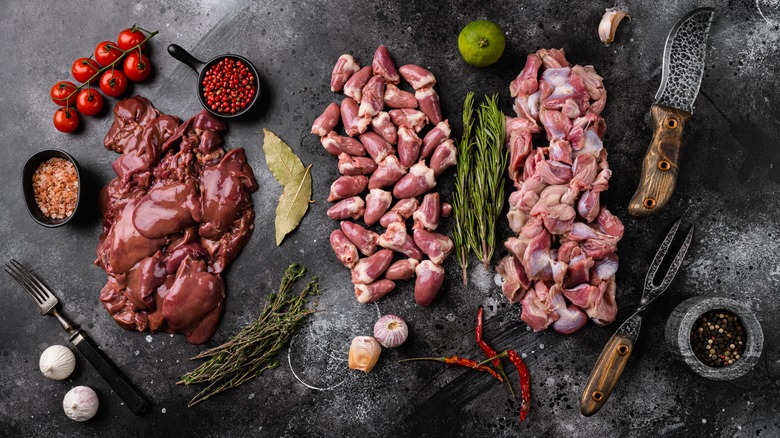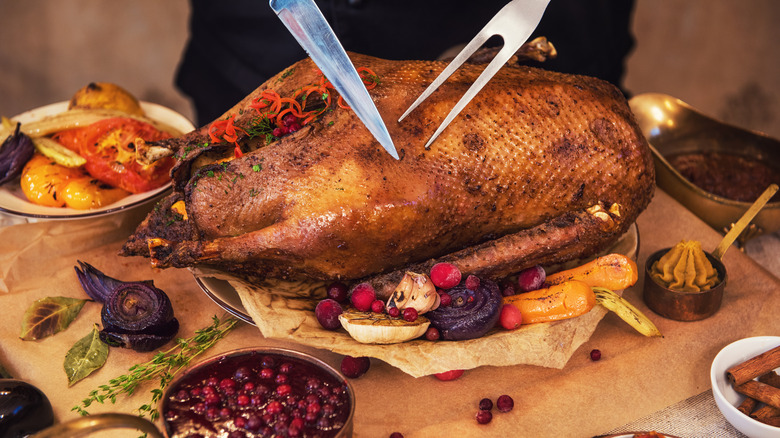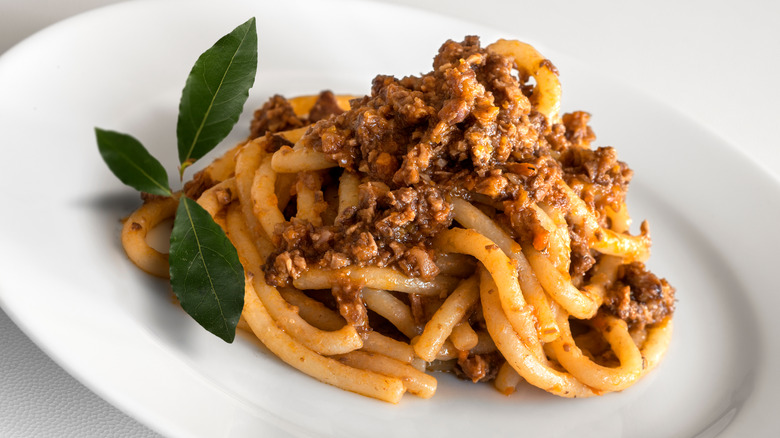14 Often Overlooked Meats You Should Try
Meat is still big, folks. Although plant-based meat alternatives continue to increase in availability and popularity, regular meat products are still part of the majority of people's diets in the United States. Almost 90% of people in the U.S. include meat in their diets, according to a poll conducted by Ipsos. The same survey, which polled over 1,000 adults of various demographics, found that most respondents thought eating red meat was fundamental to being an American. Clearly, meat isn't going anywhere anytime soon.
But although it's available on pretty much every street where there's a store or restaurant, what does it mean if you say you're a meat eater? In reality, it usually signposts that you're a fan of chicken, beef, pork, or lamb, right? Those four types of meat are the go-tos for millions of people around the world. But in reality, there are dozens of types of meat — it's just that some are more common than others. And that's why it's high time to broaden some horizons. Let's take a look at some often overlooked meats that will get your taste buds going, with some choice recipes to go along with them.
1. Goat
Goats are prized for their culinary contributions in multiple forms, with goat milk and goat cheese bringing dishes to life worldwide. But what about their meat? Well, turns out, it's pretty good too. Goat meat is a dark meat that, pound for pound, can be healthier than loads of other dark meats out there. This naturally lean meat is low in cholesterol and typically free from any of the antibiotics that are commonly used in the production methods for other animals.
Interestingly, while goat meat has a dark appearance, it's not as strong-tasting as you might think. The meat actually has a lightly sweet edge and a gentle overall flavor that makes it surprisingly versatile. Like other animals, though, its flavor can change with age, and the meat of older goats can have a more pronounced taste to it.
The main thing about goat meat, though, is that it's seriously versatile. It can be used in a variety of soups and curries and is a natural sub-in for beef in stews. Try this simple goat stew, which combines goat meat, leeks, potatoes, red wine, and herbs, for a warming, delicious dinner. Once you try it, you likely won't turn your nose up at goat again.
2. Venison
Serving venison up at the dinner table just screams class. This game meat has been around for generations, but it often gets overlooked in favor of more commonly available dark meats like beef or lamb. Well, we say that stops here. Venison is a super-viable alternative to cook up in your food and works brilliantly in heartier, comforting dishes like venison bourguignon. But its use doesn't end there: It can also be served in sandwiches, as steak, and even in the form of venison burgers.
What you need to know about venison is that although it's assumed it comes from deer, that's far from the case. Venison meat can also be produced from other animals like caribou, elk, and antelope. Additionally, venison is not just the connoisseur's choice when it comes to meat but a choice that individuals who are looking to make healthier decisions might want to make too. Ultra-high in protein, venison meat is also naturally lower in fat than some dark meats. It's also chock-full of vital B vitamins that keep your system running smoothly. Remember, though, that venison has a pretty bold, meaty flavor, and if you're looking for something more subtle, it may not be for you.
3. Duck
If you're not serving up duck now and again, you're missing out. This bird meat isn't on common rotation in a lot of people's kitchens, with only a small amount consumed per person each year, according to the USDA. But for folks who are looking for a bold alternative to chicken, duck is the next best thing. This iron-rich meat has a slightly more pronounced, gamey flavor than chicken, and a higher fat content that gives it a richer taste. This fat content also means that duck meat is far less likely to dry out, leaving you with a juicy result every time.
It's easy to make some mistakes when cooking duck, though, so make sure you're not treating it exactly like other birds. Duck generally cooks better at lower temperatures, which helps to retain its juiciness, so don't be tempted to blast it at high heat. If you're marinating your duck before cooking, ensure that you give it plenty of time to work its way into the meat to tenderize it. And, above all else, don't get rid of that valuable skin. It's pretty much the most delicious part of the whole duck, and while throwing it out will reduce its fat content, it'll also diminish its flavor.
4. Veal
Of all the types of meat out there, few are as controversial as veal. In the past, veal was held as a particularly vivid example of animal cruelty, thanks to its production methods. But advances have since been made in the care of calves reared for veal, with more humane conditions and methods. This means that, if you're asking if veal is okay to eat, you should feel a little better about the answer.
Veal, as you might expect, has a slightly milder flavor than traditional beef and is generally more succulent, too. The meat is both protein- and nutrient-rich, with good levels of iron and B vitamins delivered through eating it. Additionally, while mature beef can be high in cholesterol, veal is lower in fat and is free of hormones, due to the less invasive rearing methods employed in its production.
As veal is a tender cut of meat, it's important to treat it gently and not overcook it. Try not to overpower it with intense sauces or drown it in gravy — instead, let the flavor of the meat shine. Remember, too, that ground veal can be used alongside other meats to give a gentler flavor.
5. Pheasant
Have you had the hankering to dine like an 18th-century British noble recently? Well then, let us introduce you to pheasant. This old-school alternative to chicken is one of the best game meats for beginners out there. And the good thing is, nowadays you can get it without having to rely on hunting. Farmed pheasant has a flavor that's similar to chicken and, while still gamey, isn't too overpowering to put newbies off. Pheasant meat is also pretty lean, unlike some other chicken alternatives like duck, which tends to be higher in fat.
One of the best things about pheasants, too, is that they're usually pretty small in size. As such, if you're catering for just a couple of people, they're a perfect alternative to a large chicken or turkey. And if you're keen on pheasant for dinner, the good news is that, like chicken, it's a versatile meat. You can either get the whole bird and roast it up in the oven or use smaller cuts of meat for individual portioning. Just make sure that you're not blasting pheasant with excessive heat, as this can tend to dry it out. A "low and slow" approach is usually best for pheasant meat, with an initial sear on the skin or surface advisable for extra flavor.
6. Bison
If, today, you're gonna buy some meat, make sure it's bison meat. Okay, now that we've got the rhyming and wordplay out of the way, let's talk about why that should be the case. While you might think that bison meat is as powerful in taste as the animal itself, its flavor is actually pretty mild. Bison has a gently meaty taste, with a sweet undertone to it, and overall is pretty similar to cow meat. As a result, you can swap lean beef with bison and still achieve a similar result — and you may love the subsequent meal you make even more.
But that's not the only reason why you should try out bison meat. Pound for pound, this meat is richer in protein and lower in saturated fat than regular beef and has a wealth of vitamins and minerals packed into it. Bison meat is also not usually subject to the farming processes that cows undergo for their meat. As a result, you don't have to consider whether you're ingesting added hormones or chemicals with this meat, as you may with beef. But the best part? It's super easy to prepare. Just treat it as you would any other red meat, serve, and enjoy.
7. Rabbit
Mention rabbit as a meat to anyone, and they're likely to get a little squeamish. After all, who wants to associate those hopping animals with something you eat? We get that. But it's also important to remember that rabbits have been used for culinary purposes for thousands of years. And aside from its prominent role in food history, the real reason you should be eating rabbit is that it's a delicious, nutritious protein.
Rabbit meat is especially lean and low in cholesterol, so it makes an excellent alternative to fattier cuts of meat. It's also wonderfully versatile. One of the best ways to cook rabbit is in a stew, as this will help the meat stay moist and tender. Instead of using chicken to make a classic coq au vin, sub in rabbit meat instead. Or, you can use rabbit as you would a piece of chicken and pork and serve it up on its own, accompanied by vegetables, gravy, or a pan sauce. Whatever you choose, be assured that the eventual dish will be a protein-rich twist on your traditional meat-based dinner.
8. Alligator
Alligators are better known for their fearsome nature and predatory skills than the taste of their meat. But that doesn't mean you should write alligators off as a meat source. While slightly less available in certain parts of the country, alligator meat is more frequently found in states where the reptile is common. In Florida, alligator is somewhat of a regional specialty and is commonly found coated and deep-fried in various forms.
But the big question, of course, is what does alligator taste like? Interestingly, it's pretty mild. Alligator has a taste comparable to chicken and other white meat, with a noticeable brininess to it. Alligator meat is most commonly served in its white form, which usually comes from the reptile's sizeable tail. Like many other animals used for food, however, it also has dark meat, which has a bolder taste.
White alligator meat is pretty lean and packs a huge protein punch for its weight. It's also nutritionally pretty robust, with healthy fatty acids and minerals like iron present in the meat. Not bad, huh? Trust us: Give gator a try, and you won't be looking back.
9. Moose
Beyond the classic meat options like chicken, beef, pork, and lamb, things start to get a little interesting. And moose meat is one such interesting option. A game meat, moose has a particular boldness to it that's comparable to other wild animals used for food (per Professional Secrets). While it can be used, as other game meats are, in stews and soups, moose steak is a particularly tasty option. The sirloin cut of the moose, which is pretty lean, can be fried in the same way that a beef steak can, and it can even be served rare. This helps to keep the cut of meat tender and juicy, as it can get tough if overcooked, due to the larger protein fibers.
But you didn't think we'd stop there, did you? Oh, no, folks, we're only just getting started. For some Indigenous communities in Canada, moose meat is a firm staple on the menu. And it appears in the form of jellied moose nose, a delicacy made by forming moose meat into a loaf shape, bound together by jelly. Pickling spices are added to bring the dish to life, and it's frequently served with bread.
10. Oxtail
If you've ever seen oxtail in the store, you may have wondered what the heck it actually is. Is it seriously the tail of an ox? Will it taste strange? And how do you cook it?
Well, people, we're here to answer all of those questions and to assure you that oxtail should be on your weeknight meal rotation. While "oxtail" traditionally refers to — you guessed it! — the tail of an ox, nowadays it's a term that can describe a few different types of meat. Most frequently, oxtail is simply the tail of a cow, which is divided up and sold in portions. Although it's easy to assume that tail meat is substandard, that's far from the case. As part of the tailbone is in each piece of oxtail, cooking it results in the release of collagen and marrow. This, alongside the protein-packed meat, imbues any oxtail-based dish with a huge amount of delicious, rich flavor.
Given that oxtail cuts are part bone, part meat, they're best used in liquid-based dishes like stews or soups. Try throwing them into a slow cooker with some red wine, butternut squash, and pearl onions. Simmer on low heat for six to eight hours to let those juices melt into the pot and then serve to delicious, grateful guests.
11. Mutton
Human society has a lot to be grateful to sheep for. In addition to their wool being useful for clothing and their milk for sustenance, sheep are also a key provider of meat. But while most of us are probably familiar with the taste of lamb, not all of us have tried mutton, which comes from the same animal. So what's the difference between lamb and mutton?
Essentially, it all comes down to age. While lamb comes from younger sheep, generally no older than a year, mutton is from slightly more mature animals. As you might expect, this develops the flavor of the meat slightly, with mutton having a gamier taste. Mutton generally also has a higher fat content and can be a little less tender than lamb.
Despite this, though, mutton is still delicious, protein-rich, and an excellent substitution for lamb and other dark meats. The secret to preparing it well lies in the cooking. Mutton requires a longer cooking time than lamb to soften it up sufficiently and is best used in meals like curries or stews. Or, for a simply prepared meal with a huge punch of flavor, try this garlic mutton recipe.
12. Organ meat
When it comes to meat, the vast majority of us know the cuts we like. Breast, thigh, flank, leg, shank — all are in constant rotation on tables around the world. But this leaves a huge amount of the animal we're eating that could potentially go to waste, including its organ meat. And, although you may balk at the idea of eating livers, kidneys, or hearts, the fact remains that they're viable, nutritious sources of protein.
Although animal hearts are Valentine's Day-themed fare, there's far more to them than that. Beef and lamb hearts are protein, mineral, and collagen-rich foods that are also easy on the wallet. Their flavor, too, isn't as different or strong as you may think, with beef hearts tasting similar to other, more traditional cuts of the animal. If heart isn't your thing, though, we recommend you give liver, a similarly budget-friendly meat, a try. Liver with Bacon and Onions is a traditional, tantalizing British dish. Simply fry up some bacon and onions together and then sauté some liver separately. Deglaze the pan with a little bit of wine, add a combination of butter and flour, and then pour the sauce over the meat and onions.
13. Goose
When Christmas rolls around, what do you normally serve on the big day? Maybe a classic Christmas ham or a second round of turkey after Thanksgiving? Well, if you're a little bored of the same old meat on your Christmas table, it's time to give goose a go. Goose is arguably a more flavorful version of turkey, thanks to the bird's higher fat content, which diffuses moisture through the meat. A full goose also has the distinct advantage of being slightly smaller than a turkey, meaning that you may not be left with any pesky leftover meat.
Crucially, cooking a Christmas goose is a breeze and isn't that much different from cooking a turkey. One thing you will need, however, is a rack in your baking sheet or roasting tin. By placing the seasoned, stuffed goose on a rack, the excess fat can drip off the bird. This leaves you with perfectly tender meat that isn't swimming in grease, and super-crispy skin. An average-sized goose will usually take between two and three hours in an oven at 350 degrees Fahrenheit. Don't forget to let the bird rest, too: That will allow all of the juices to seep back into the meat.
14. Boar
While pork, in its many forms, is a common fixture on menus across the United States, boar is slightly less frequently seen. But this meat, from the relative of the common pig, is a delectable food in its own right. Boar has a slightly bolder taste than pork, with a slight nuttiness and complexity, and the meat is a little darker than those familiar pinkish pork tones (via Northfork Bison). It also tends to have less fat running through it compared to pork and a pleasing versatility, standing up well in shepherd's pie, sandwiches, or as a standalone roast.
For boar's full flavor, however, go for boar shank, with a host of vegetables. The boar shanks are seared to develop flavor and color and then braised alongside a medley of carrots, onions, and celery. Meanwhile, rutabaga, beets, and baby carrots are roasted together with rosemary and garlic. The whole thing is accompanied by a celeriac puree and topped with pomegranate seeds. Once you've tried boar this way, you're unlikely to go back to only eating regular pork.
